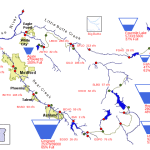Ashland Citizens Need to Brace for Another Hefty Increase in Water Rates!! Email Your Councilors!!
 |
| More $$$ Down the Drain The Ashland city government is finding new ways of wasting more ratepayers’ money on water treatment. Here are the latest developments since our Alert last September: In an unprecedented move, the Council voted 4-2 at a recent study session to direct Public Works staff to explore adding solar panels to a proposed new water plant which would qualify the city for a Gold Envision environmental award. The motion was made by Councilor Tonya Graham, seconded by Councilor Jensen, and supported by Councilors Hyatt and Seffinger. In a presentation in support of the motion, Council was told that Ashland has 320 to 330 sunny days a year, which is 20 to 30 days more than Phoenix, Arizona, 60 more than Key West Florida and 10 more than Yuma the sunniest city in Arizona, as measured by the US Weather Bureau. Its Ashland figure is 198 sunny days on average. Envision is a Washington, DC organization that recognizes infrastructure projects that meet certain environmental goals. While the four are pushing for bragging rights attached to this environmental medal, they haven’t justified building the new $32 million plant on which the solar panels would be placed. They haven’t asked for an Environmental Impact Study to be undertaken on the impact of building an entirely new water treatment plant. Nor have they asked for a greenhouse gas emissions comparison between a new plant and the existing plant, in direct contradiction to the primary goal of CEAP, the city’s climate initiative. Construction of a new water plant would be the single largest generator of greenhouse gas emissions in the city’s current $300 million capital improvement plan. The existing water plant already has a fully paid for, time-tested, on-site green source of backup power – a 850KW hydropower turbine that can run the plant 24/7/365 and more. Why, while trying to tame a budgetary crisis, would the city consider spending more than $2 million on solar panels to build a less reliable source of backup power that is too small to power the water plant most of the time? With the current water plant, the city doesn’t have to spend a dime for additional environmental improvements. Also, the payback period for the solar panels was not presented by the 4 Councilors. However, given that solar panels need to be replaced ever 20 to 25 years and the cost estimate does not include storage batteries or a possible solar ground array, the economic case for proceeding with this proposal is questionable at best. Ashland ratepayers could be on the hook for years, if not decades. It is also surprising that public works would be moving forward without a hydraulic flood study or seismic structural evaluation performed by a qualified engineering specialists that showed this proposed new water plant is actually needed. In the meantime, a new consulting firm, the sixth working on the proposed city water issue, increased the estimated cost of upgrading the city’s existing water plant by 350%. The timing of this added cost update from Public Works seems more than coincidental. Consider data from the System Development Charge Committee (a group tasked with looking at costs to build in Ashland) in the fall of 2021. It discovered that building costs in Ashland could be substantially reduced if the city opted to refurbish the present plant instead of building a new one. Four years ago, an Overland Park KS consultant estimated it would cost $5.8 million to upgrade the existing 7.5 million gallons per day treatment plant. Last year, the Public Works Department upped that estimate to $8 million. Yet the new estimate from HDR of Omaha puts the upgrade cost at $27.3 million! (And the city has spent $3.75 million to date on water consulting contracts.) According to a memo sent to the City Council by Public Works Director Scott Fleury, this huge increase would pay for algae treatment, an issue previously thought to be of such insufficient concern that it wasn’t even raised by any of the previous consultants. Last year, a Conservation Commission member was told by Fleury that the late summer algae problem could be corrected through an ozone chemical treatment program. Now it’s a $14 million issue. Additionally new plans are also underway to improve the Talent-Ashland-Phoenix (TAP) connector line with the Medford water system. During a drought several years ago, the city spent more than $13 million to connect into the TAP water line from Medford. Medford water was extensively used during last summer’s drought and according to Fleury, buying water from Medford is now cheaper than operating either the current plant or a new one. However, because the city wouldn’t be able to get enough water from TAP to meet its needs during peak months, we require a water treatment plant of our own. The major options have been to build an entirely new plant lower down in the Ashland Creek Valley from the existing plant, or rehab the old one, which was reconstructed in 1993 to serve the city for 50 years. It still has at least 25 years of operating life. While Ashland Citizens for Economic Sustainability (ACES) believes environmental improvements are key components to the community’s future, we also strongly encourage the City Council to also consider the costs. Ashland utility rates already are the highest in the valley, and low and moderate income residents, many of whom have fixed incomes, are disproportionately affected by expensive city decisions on infrastructure improvements. Click here to email your message to the council about reducing cost on this project |






